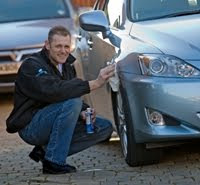 I usually take my annual holiday abroad in the winter and near the end of my well earnt rest I decided to check the weather forecast at home. Although there is no snow forecast for the near future around my area, the recent mornings have been very icy and you never know when the weather will take a turn for the worse.
I usually take my annual holiday abroad in the winter and near the end of my well earnt rest I decided to check the weather forecast at home. Although there is no snow forecast for the near future around my area, the recent mornings have been very icy and you never know when the weather will take a turn for the worse.
It made me think of an situations few years ago when my wife went out on a reasonably good day weather wise a few of winters back. Arriving at the destination with my two elderly parents in tow they went in for a two hour meeting. Whilst in there the snow began to fall heavily, settling and getting deeper all the time. Against their better judgement they decided to take a chance and head for home as soon as possible. This is where it all started to go wrong!! The roads became gridlocked and they got stuck in the bad weather for around 6 hours, arriving home on the back of a recovery vehicle well past midnight.
The situation was made worse by the fact they had set out totally unprepared. No blankets or shovels , we hadn't checked the weather forecast. We also had an automatic car and my wife was unfarmilar with the car settings for driving in that kind of weather, so ended up with a burnt out clutch.
From then on we vowed never to get in that situation again!! We follow these simple steps during the winter months:
1.Before you even get in the car, plan your journey – and where possible try to come up with a route which avoids smaller country lanes/ minor roads, as these are less likely to have been gritted
2.Make time to properly clear your car of snow and ice to ensure full visibility – this includes removing snow from the bonnet and roof, front and rear windscreen, windows and mirrors. You must also make sure your lights and number plate are clear of snow.
3.When pulling away, use 2nd gear and try to avoid high revs as this will just cause the wheels to spin. In automatic vehicles check your handbook for any special settings the car may have for driving in poor weather.
4.The Institute of Advanced Motorists recommend maintaining as constant a speed as possible when driving in snow; don’t drive too fast otherwise you risk losing control, and not so slowly that you might lose momentum for getting up a hill. Also try to steer and corner as smoothly as possible but make sure you’ve braked to the necessary speed before attempting to corner in snowy and icy conditions, otherwise you risk skidding.Whilst driving take extra care and keep your distance between you and the vehicle in front. Stopping distances can increase by up to ten times in snowy and icy conditions, so it is imperative to keep this in mind.If driving on the motorway, keep to the clearer lanes and try to drive within the tracks made by the cars in front. Again, keep your distance.Make sure to use dipped headlights or fog lights when driving in falling snow to ensure you are visible to others.
5. Fitting Winter tyres is a really good idea. At the very least make sure your tyres have a good amount of tread – 1.6mm is the legal limit, but the more the better.
6.Keep an eye on the weather forecast and listen out for traffic reports, things can vary dramatically within just a few miles and within a small amount of time.In the unfortunate event of a breakdown or getting stuck in the snow, it is handy to keep a few things in the car just in case. These include: food and water, a shovel, blanket, boots, phone charger and a tow rope. If possible, it’s also a good idea to keep some old pieces of carpet in the car to put under the tyres, to help give you some traction for pulling away.And above all, only drive in these conditions if it is absolutely essential.
Hope these tips will help with safe winter driving, if you have any tips of your own or comments please let me know so I can pass them on to my Customers when onsite.
Thanks for reading
Paul
